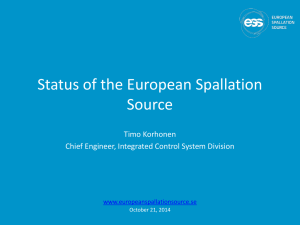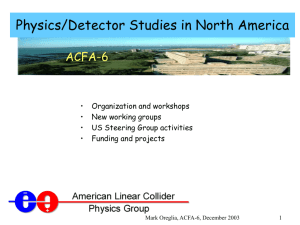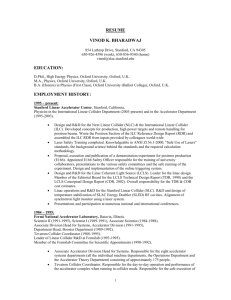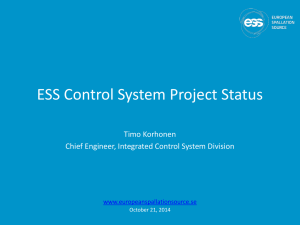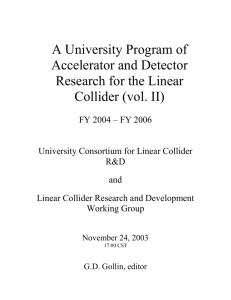Microsoft Word version of introductory material
advertisement
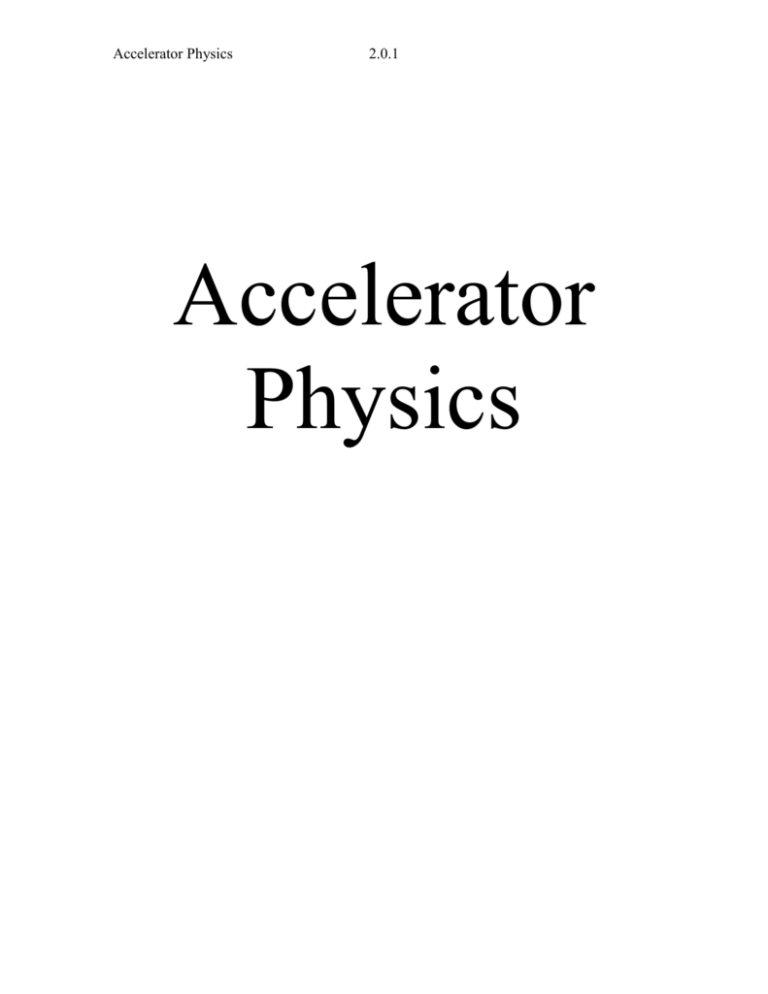
Accelerator Physics 2.0.1 Accelerator Physics Accelerator Physics 2.0.2 Accelerator Physics Table of Contents Table of Contents and Overview .................................................................................... 2.0 1. Beam Halo Monitor & Instrumented Collimators (LCRD; Lucien Cremaldi) ........... 2.1 2. Beam Test Proposal of an Optical Diffraction Radiation Beam Size Monitor at the SLAC FFTB (LCRD; Yasuo Fukui) ............................................................................... 2.2 3. Design and Fabrication of a Radiation-Hard 500-MHz Digitizer Using Deep Submicron Technology (LCRD; K.K. Gan) ................................................................... 2.3 4. RF Beam Position Monitors for Measuring Beam Position and Tilt (LCRD; Yury Kolomensky) ................................................................................................................... 2.4 5. Non-intercepting electron beam size diagnosis using diffraction radiation from a slit (UCLC; Bibo Feng) ........................................................................................................ 2.5 6. Single-shot, electro-optic measurement of a picosecond electron bunch length (UCLC; Bill Gabella) .................................................................................................................... 2.6 7. Fast Synchrotron Radiation Imaging System for Beam Size Monitoring (UCLC; Jim Alexander)....................................................................................................................... 2.7 8. Radiation damage studies of materials and electronic devices using hadrons (LCRD; David Pellett) .................................................................................................................. 2.9 9. BACKGAMMMON: A Scheme for Compton backscattered photoproduction at the Linear Collider (UCLC; S. Mtingwa) ........................................................................... 2.10 10. Ground Motion studies versus depth (LCRD; Mayda Velasco) ............................. 2.11 11. Investigation of GAN Techniques in the Development and Operation of the TTF Data Acquisition System (UCLC; Don Hartill) .................................................................... 2.14 12. Investigation of acoustic localization of rf cavity breakdown (LCRD; George Gollin) ....................................................................................................................................... 2.15 13. RF Cavity Diagnostics and Acoustic Emission Tests (LCRD; Lucien Cremaldi) . 2.17 14. Control of Beam Loss in High-Repetition Rate High-Power PPM Klystrons (LCRD; Mark Hess) .................................................................................................................... 2.18 15. Research in Superconducting Radiofrequency Systems (UCLC; H. Padamsee) ... 2.20 16. RF Breakdown Experiments at 34 Ghz (UCLC; J.L. Hirshfield) ........................... 2.21 Accelerator Physics 2.0.3 17. Investigation of Novel Schemes for Injection/Extraction Kickers (LCRD; George Gollin) ........................................................................................................................... 2.22 18. Ring-tuned, permanent magnet-based Halbach quadrupole (LCRD; James Rosenzweig) .................................................................................................................. 2.23 19. Investigation and prototyping of fast kicker options for the TESLA damping rings (UCLC; Gerry Dugan) .................................................................................................. 2.25 20. Continuing Research and Development of Linac and Final Doublet Girder Movers (LCRD; David Warner) ................................................................................................ 2.26 21. Effects of Coherent Synchrotron Radiation in Linear Collider Systems (LCRD; James Ellison) .......................................................................................................................... 2.27 22. Improved simulation codes and diagnostics for high-brightness electron beams (UCLC; Courtlandt L. Bohn) ........................................................................................ 2.29 23. Beam simulation: main beam transport in the linacs and beam delivery systems, beam halo modeling and transport, and implementation as a diagnostic tool for commissioning and operation (UCLC; Dave Rubin) ............................................................................. 2.30 24. Damping ring studies for the LC (UCLC; S. Mtingwa) ......................................... 2.32 25. A Compact Wakefield Measurement Facility (LCRD; Young-Kee Kim) ............. 2.33 26. Experimental, simulation, and design studies for linear collider damping rings (UCLC; Joe Rogers) ..................................................................................................... 2.34 27. Undulator-Based Production of Polarized Positrons (LCRD; William Bugg) ....... 2.37 28. Development of Polarized Photocathodes for the Linear Collider (LCRD; Richard Prepost) ......................................................................................................................... 2.40 29. Transverse phase-space measurements for a magnetic bunch compressor by using phase-space tomography technique (LCRD; Feng Zhou) ............................................ 2.42 Accelerator Physics 2.0.5 Overview of Proposed Projects on Accelerator R&D The linear collider is an ambitious project. The center of mass energy will be a factor of 5 to 10 larger than that achieved at the SLC, and the required luminosity is four orders of magnitude larger than the SLC luminosity. The reliability required for performing high energy physics places difficult demands on the accelerating structures and their associated RF systems. The need for high luminosity places extreme demands on all of the accelerator systems due to the need to produce and maintain a very low emittance beams with very large bunch energy and beam power. Two technological solutions have been extensively developed. One uses an innovative RF source at XBand with a normal-conducting structure design (NLC/GLC), and the other uses a more conventional RF source at Lband with a superconducting RF structure design. Most of the research and development work has been done at the large laboratories, which have the engineering resources for large-scale prototyping (of, for example, accelerating structures, modulators, klystrons, and RF distribution systems) and the resources to build large test facilities (e.g., FFTB, NCLTA and ASSET at SLAC, ATF at KEK, and TTF at DESY). These test facilities have partly demonstrated that the concept of a Linear Collider may be feasible in reality. However, considerable additional work is required before a 0.5 to 1.0 TeV cms linear collider can be successfully constructed and operated. Challenges exist in beam dynamics, source technology, RF technology, magnet and kicker technology, ground motion characterization, vibration suppression and compensation, instrumentation and electronics, and control systems. Summary of R&D Covered by the Proposal The sub-proposals presented here represent an initial overlap of what university groups can do and what the lab groups have suggested is needed. Since linear collider construction is expected to be underway in less than about ten years, these sub-proposals are expected to bear fruit on a commensurate time scale. Although these sub-proposals represent an early step in the development process, they span a rather significant part of the work that needs to be done. We present below a brief summary, organized by major topic, of the how the sub-proposals meet the R&D needs of the Linear Collider program. Among the topics still needing attention are ultra precise (~1 nanometer) beam size monitors for the interaction point, cryogenic sensors (for superconducting final doublet vibration control), and superconducting quadrupole vibration system tests. Accelerator Physics 2.0.6 Beam simulations and calculations The linear collider must produce and maintain a beam with unprecedented low emittance, with low jitter, low losses, and few halo particles. It must also preserve the polarization of the electrons (and possibly positrons). Beam dynamics simulations and calculations are needed to learn to control the effects that cause emittance growth, jitter, particle and polarization loss, and halo production. The beam in the injector system, comprising sources (D), damping rings (E,F) and bunch compressors, is susceptible to space charge effects; dynamic aperture limitations from damping wigglers and chromaticity correction; emittance growth from misalignments and intrabeam scattering; instabilities from electron clouds, ions, and wake fields; and coherent synchrotron radiation (B,I). In the main linac the emittance must be preserved in the presence of wake fields and alignment errors (C,G). The transport and collimation of the beam halo is a serious concern for detector backgrounds (G, H). Each of these areas requires substantial additional calculational work before a linear collider can be successfully built and operated. B. C. D. E. F. G. I LCRD 2.27 LCRD 2.33 UCLC 2.29 UCLC 2.32 UCLC 2.34 UCLC 2.30 LCRD 2.42 Effects of Coherent Synchrotron Radiation James Ellison in Linear Collider Systems A Compact Wakefield Measurement Young Kee Facility Kim Improved simulation codes and Court Bohn diagnostics for high-brightness electron beams Damping ring studies for the LC Sekazi Mtingwa Experimental, simulation, and design Joe Rogers studies for linear collider damping rings Beam simulation: main beam transport in Dave Rubin the linacs and beam delivery systems, beam halo modeling and transport, and implementation as a diagnostic tool for commissioning and operation Transverse phase-space measurements for Feng Zhou a magnetic bunch compressor by using phase-space tomography technique New Mexico U Chicago Northern Illinois MIT and NCA&T Cornell Cornell UCLA Electron and positron source technology Positron sources for the linear collider could be of the conventional type, with several operating in parallel to avoid fracturing targets, or could be based on undulator radiation striking a thin target. The latter idea has advantages including the possibility of producing polarized positrons, but suitable undulator prototypes must be produced, and a beam test of the principle is desirable (A) Other work includes studies of photocathodes (B). Accelerator Physics 2.0.7 A. LCRD Undulator-Based Production of Polarized 2.37 Positrons B. LCRD Development of Polarized Photocathodes for 2.40 the Linear Collider William Bugg Richard Prepost Tennesee SouthCarolina Wisconsin RF Technology The design of the X-band main linacs is limited in accelerating gradient performance by electrical breakdown of the rf structures. On the other hand, the gradient performance of superconducting cavities is limited by the Q of the cavities. The cost of the X-band design would be reduced if the power output capability of the X-band klystrons were increased. Understanding the sources of the breakdowns in the X-band structures and increasing the performance of the klystrons are important for demonstrating the technical performance of NLC main linacs and reducing their costs (A, B, C, E). Understanding the limitations of superconducting cavities and extending their performance will allow for an enhanced energy goal for the TESLA main linacs, reduced cost, or both (D). A. LCRD Investigation of acoustic localization of rf 2.15 cavity breakdown B. LCRD RF Cavity Diagnostics and Acoustic Emission 2.17 Tests C. LCRD Control of Beam Loss in High-Repetition Rate 2.18 High-Power PPM Klystrons D. UCLC Research in Superconducting Radiofrequency 2.20 Systems E. UCLC RF Breakdown Experiments at 34 GHz 2.21 George Gollin Lucien Cremaldi Mark Hess Illinois Mississippi MIT Hasan Cornell Padamsee J. Hirshfield Yale Kicker and Magnet Technologies One of the novel and controversial features of the TESLA design is its large damping rings which require fast kickers to inject and eject bunches one at a time. The circumference (and presumably the cost) could be reduced if faster kickers were available (A, D). Permanent magnet technology is attractive for many parts of any linear collider complex. These include the fixed energy damping rings, beam transport lines, and the X-band main linacs. This technology offers the possibility of eliminating costs associated with electromagnets which require power supply systems, and may require cooling water systems. The performance capabilities of magnets based on permanent magnet materials (especially their radiation resistance) must be understood before considering them for reducing the costs of several subsystems throughout linear colliders (B). Accelerator Physics 2.0.8 A. LCRD Investigation of Novel Schemes for 2.22 Injection/Extraction Kickers B. LCRD Ring-tuned, permanent magnet-based Halbach 2.23 quadrupole D. UCLC Investigation and prototyping of fast kicker 2.25 options for the TESLA damping rings George Illinois Gollin James UCLA Rosenzweig Gerry Dugan Cornell Ground Motion, Vibration, and Mechanical Support Systems The choice of a site for a linear collider will include consideration of the vibrations inherent at the site. The characterization of ground vibrations as a function of depth will help determine the depth at which a linear collider will have to be located (A). The rf structures and magnets in the NLC main linacs will have to be accurately moved and, due to their great number, the development of an inexpensive system to do this will reduce costs. The final focus magnets in NLC and TESLA also require movers with even greater accuracy but their number is smaller (B). A. LCRD Ground Motion studies versus depth 2.11 B. LCRD Continuing Research and Development of 2.26 Linac and Final Doublet Girder Movers Mayda Velasco David Warner Northwestern Colorado State Instrumentation and electronics The very small vertical and longitudinal emittances of a linear collider beam are near or beyond present beam size resolution limits. The linear collider will require the development of monitors surpassing the performance of present designs (A, B, E, F, G). Sensitive monitors for transverse-longitudinal beam “tilt” would improve the ability to minimize emittance growth (D). Control of the beam halo requires a monitor which can detect low intensity halo despite the presence of a high intensity beam core. The linear collider will have special requirements for electronics: radiation hardness, speed and depth of data acquisition, and reliability (C, I). A. LCRD Beam Halo Monitor & Instrumented 2.1 Collimators B. LCRD Beam Test Proposal of an Optical Diffraction 2.2 Radiation Beam Size Monitor at the SLAC FFTB C. LCRD Design and Fabrication of a Radiation-Hard 2.3 500-MHz Digitizer Using Deep Submicron Technology Lucien Mississsippi Cremaldi Yasuo Fuki UCLA K. K. Gan Ohio State Accelerator Physics 2.0.9 D. LCRD RF Beam Position Monitors for Measuring 2.4 Beam Position and Tilt E. UCLC Non-intercepting electron beam size diagnosis 2.5 using diffraction radiation from a slit F. UCLC Single-shot, electro-optic measurement of a 2.6 picosecond electron bunch length G. UCLC Fast Synchrotron Radiation Imaging System 2.7 for Beam Size Monitoring I. LCRD Radiation damage studies of materials and 2.9 electronic devices using hadrons Yury UC Berkeley Kolomensky Bibo Feng Vanderbilt Bill Gabella Vanderbilt Jim Cornell Alexander David Pellett UC Davis Control Systems The international nature of the linear collider collaboration lends itself to the possibility of a truly global accelerator network for controlling the machine. Exploration of the capabilities of such a network and its basic unit (the virtual control room) will help demonstrate the feasibility of this technique (A). A. UCLC Investigation of GAN Techniques in the 2.14 Development and Operation of the TTF Data Acquisition System Don Hartill Cornell Non-e+e- collisions A major facility like the Linear Collider should enable a broad spectrum of physics programs. In addition to the high energy e+e- operation, other possible programs include Z-pole studies at a separate collision region, e-e- or at the high energy region, or Compton backscattered photons from the spent beams. In the latter case, there is a novel program with polarized photons on fixed target, and also a platform for prototyping the laser-beam issues for without disrupting the initial high energy e+e- program. A. UCLC BACKGAMMMON: A Scheme for Compton 2.10 backscattered photoproduction at the Linear Collider We now present the accelerator R&D sub-proposals. Sekazi Mtingwa MIT and NCA&T



